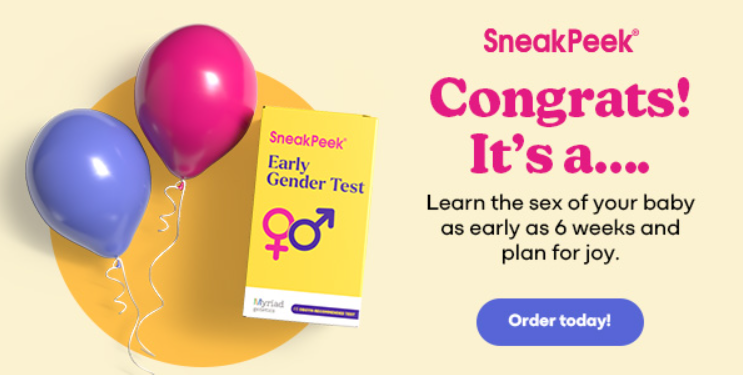Published on September 1st, 2020 and Updated on October 15th, 2025
Check out SneakPeek Gender Test to find out your baby’s gender as early as 6 weeks with over 99% accuracy!

As you start on your journey to becoming a parent, you may dream of what your child will be like. Maybe you picture a softball champ who loves your mac and cheese recipes as much as she loves water colors. Or maybe you picture a dancer whose amazing natural rhythm only rivals his math skills. You may even keep your daydreams simple—a little boy, or a little girl.
With the variety of sex prediction tests available, from the Chinese gender calendar to the pencil gender test, is there also a way to improve the chances of having a specific sex?
Doctor, biologist, and reproduction scientist Dr. Landrum B. Shettles thought so.
Since 1960, couples have been trying to sway the odds for a baby girl or a baby boy using the Shettles method. What is the Shettles method, exactly, and how accurate is it?
What is the Shettles method?
Built off the work of Dr. Shettles, the Shettles method essentially states that couples can determine the sex of their baby by creating the best environment for certain sperm—either sperm carrying an X chromosome (girl) or a Y chromosome (boy)—to thrive. But the science behind this practice is a bit more complicated than just putting out a welcome mat for preferred sperm.
In his pursuit to find a sex-specific determining method, Shettles researched everything he thought might affect the sex of a fetus, including the timing of sexual intercourse, sexual position, pH of bodily fluids—that is, the acidity of bodily fluids—and sperm. Based on his observations, Shettles believed that sperm carrying an X chromosome differed from sperm carrying a Y chromosome. He broke sperm down into two categories, Y-sperm and X-sperm.
- Y-Sperm – This sperm carries a Y chromosome and has the potential to create a boy. Shettles thought this particular sperm was faster, but had a shorter life span than X-sperm. He also believed that Y-sperm swim quicker in alkaline environments—or environments that weren’t very acidic—like the cervix and the uterus.
- X-Sperm – This sperm carries an X chromosome and has the potential to create a girl. In contrast with the Y-sperm, Shettles theorized that X-sperm are slower, but more resilient. The researcher also believed that X-sperm thrived in more acidic environments, like in the vaginal canal.
So for Shettles, the question became—how do couples create more accommodating environments for a specific kind of sperm?
How a baby’s sex is determined: a crash course
Understanding the basics of how a baby is made—on a cellular level, not a “birds and the bees” level—can help illuminate Shettles’ theory.
Key terms involved in conception
First, let’s review some reproductive terminology:
- Sperm – Sperm is the male reproductive cell. It carries the father’s DNA and fertilizes the egg to create an embryo—the cluster of cells that become a baby.
- Egg – Not the kind you buy in a dozen. When it comes to human reproduction, an egg is the female reproductive cell. It holds the parent’s DNA and resides in the ovaries, and every month one egg is released into the fallopian tube and makes its journey into the uterus.
- Embryo – Once the sperm fertilizes the egg, together, they make a whole greater than the sum of their parts—an embryo, the beginnings of a baby.
- Chromosome – Genetic information carried by both the egg and the sperm are called chromosomes. To create an embryo, the egg provides half of the chromosomes, while sperm the other.
How is the sex of a fetus determined?
As adults, we know that a baby’s sex isn’t determined by whatever the stork happens to pick up on your due date. Sex is determined at conception. So, what determines the gender of a baby?
When a man ejaculates, he releases between 40 million and 1.2 billion sperm. These sperm have to travel all the way through the vaginal canal, the cervix, and into the uterus to fertilize the egg. However, only about 100,000 sperm make it into the uterus for a variety of reasons including:
- Having weirdly shaped “tails” that keep them from “swimming” well
- Missing essential structural parts that make male sperm cells unfit for the journey
- Some sperm go too far and land in a woman’s interstitial fluid, the fluid that surrounds her internal organs
And out of those 100,000, only one sperm makes it all the way into the egg to create an embryo. Once that winning sperm penetrates the egg’s membrane, the egg forms a protective “shell” so no other sperm can enter. From there, the egg and sperm each bring their own DNA to form the embryo—and the chromosomes in that DNA determine the baby’s sex.
These sex chromosomes can be either X or Y—women have two X chromosomes while men have one X and one Y. The egg always provides an X chromosome, and the sperm provides either an X or a Y. If an X-carrying sperm fertilizes the egg, the embryo will have two X chromosomes and become a girl. If a Y-carrying sperm fertilizes the egg, the embryo will have one X and one Y and become a boy.
How to try the Shettles methods
All of Shettles’ studies of the human reproductive system led to his theory on how to create ideal environments for Y- or X-sperm. Shettles believed that ovulation, menstrual cycles, the female orgasm, and sexual position could all play a part in sex selection and swaying the odds for a boy or a girl baby.
How to try for a boy with the Shettles method
According to Shettles’ observations, Y-sperm preferred alkaline—or not so acidic—environments. If you’re wondering how to have a baby boy, here are his recommendations for giving Y-sperm their best shot at fertilization for a male fetus:
- Timing intercourse on the day of a woman’s ovulation day and up to 2-3 days later – Because a woman’s pH levels change based on her cycles, Shettles believed a woman was at her lowest acidity (and highest pH) just after ovulation.
- Try deeper penetration – Dr. Shettles believed that alkaline environments like the cervix and the uterus were ideal for Y-sperm. So the closer the ejaculate could get to those environments, the better. Shettles recommended couples who wanted a boy try sexual positions that allowed for the deepest possible penetration, specifically he advised entering the woman from behind.
- Let the parent-to-be orgasm first – Yup, Shettles even believed the female orgasm could affect the pH of the vagina. Because he thought that a woman’s natural post-orgasm secretions were more alkaline, he recommended women orgasm first to help create an alkaline environment for Y-sperm.
How to try for a girl with the Shettles method
Shettles believed X-sperm thrived in acidic environments. He theorized that adjusting the pH of a woman’s reproductive arena would help parents improve their chances of conceiving a baby girl. The recommendations for increasing the chances of a X-sperm are pretty much the opposite of the Y-sperm:
- Save sex for after menstruation and stop before ovulation – To create a more acidic environment for X-sperm, Shettles recommended couples have sex right after a woman’s menstrual cycle—when he thought the vagina was at its most acidic—and stop sexual intercourse three days before ovulation.
Try shallower penetration – According to Dr. Shettles, the high acidic environments of the vaginal canal were ideal for X-sperm. The idea was that X-sperm would speed on through the canal and into the womb while the Y-sperm, which preferred less acidic environments, would slow down or die off.
To do so, Shettles recommended couples try sexual positions that allowed for shallow penetration—like face-to-face or missionary—so the ejaculate deposit can be focused in the vaginal canal.
- Timing the female orgasm – Shettles thought that after a woman orgasmed, her vagina would naturally secrete alkaline fluids, which would increase her pH—making conditions less acidic and therefore less accommodating to X-sperm. He advised women to wait until their partner had ejaculated to orgasm.
How accurate is the Shettles method?
While Shettles certainly was a pioneer in his day, the scientific accuracy of his method for a desired sex is a bit murky.
So, does the Shettles method work? Although Shettles himself claimed his method has a 75% accuracy, independent researchers have disproved various aspects of his accuracy and methodology, such as sperm differences, several times over the past few decades. Using the Shettles method does not guarantee sex selection. The only way to guarantee the sex of the fetus would be through a preimplantation genetic diagnosis which may be part of a test done during in vitro fertilization. One research team even went so far as to disprove his claim on the different characteristics of X- and Y-sperm. On the other hand, several parenthood influencers and mommy-bloggers swear by the Shettles method.
So really, it’s up to you if you want to try the Shettles method. The good news? You can check Shettle’s accuracy for yourself with the SneakPeek Early Gender Test!
Confirm Your Gender Swaying with SneakPeek
Whether you’re keeping your fingers crossed for a beautiful baby boy or a gorgeous baby girl, your parenting journey will be one full of discovery. And if you’re trying for one over the other, you may be counting down the days until you can find out whether your gender swaying methods worked.
Thanks to SneakPeek, you can find out your baby’s sex —and if your chosen sex-determining practices succeeded—as early as 6 weeks.
The SneakPeek Early Gender Test is a safe, easy-to-use, at-home gender blood test that lets you learn your baby’s sex in just a few days. And with a clinically-proven over 99% accuracy1 rate, the SneakPeek test can help you feel confident about your soon-to-be son or daughter and what color to paint the nursery.
Learn more about your baby today with the SneakPeek® test!
Editorial Policy
At SneakPeek, our commitment is to provide accurate, up-to-date, and reliable information to empower our readers. Our content is thoroughly researched, reviewed by medical experts, and fact-checked to ensure its credibility. We prioritize the well-being and education of our readers, and our editorial policy adheres to the highest standards of integrity and accuracy in all our articles.
This post has been reviewed for accuracy by the following medical professional:
Dr. Heather Soper, Certified Nurse Midwife
Dr. Heather Soper brings over 15 years of experience in women's health and obstetrics to her role as the owner of The Genesis Resort for Birth. Complementing her clinical practice, she serves as an Assistant Professor of Nursing at James Madison University, where she educates nursing students with a focus on compassionate, patient-centered care. Her advanced training and dedication to midwifery are evident in her contribution to both academia and the wellness of expectant mothers
Sources:
- The New York Times. Dr. L.B. Shettles, 93, PIoneer in Human Fertility. https://www.nytimes.com/2003/02/16/nyregion/dr-l-b-shettles-93-pioneer-in-human-fertility.html
- McGraw-Hill Medica. Medical Terminology in a Flash! Chapter 11: Reproductive System. https://fadavispt.mhmedical.com/content.aspx?bookid=2641§ionid=217178928
- Frontiers in Cell and Developmental Biology. New Biological Insights on X and Y Chromosome-Bearing Spermatozoa.
https://www.frontiersin.org/articles/10.3389/fcell.2019.00388/full#h6 - Healthline Parenthood. 12 Widely Believed Sperm Facts That Are Actually False. https://www.healthline.com/health/mens-health/sperm-myth-and-facts#8.-Every-sperm-is-healthy-and-viable
- Springer. Trends in Population Sex Ratios May be Explained by Changes in the Frequencies of Polymorphic Alleles of a Sex Ratio Gene. https://link.springer.com/article/10.1007/s11692-008-9046-3
- National Library of Medicine. Lack of significant morphological differences between human X and Y spermatozoa and their precursor cells (spermatids) exposed to different prehybridization treatments.
- https://pubmed.ncbi.nlm.nih.gov/11191075/
- Psychology Today. Boy or Girl: Couples Trying to Load the Dice. https://www.psychologytoday.com/us/blog/how-we-do-it/201808/boy-or-girl-couples-trying-load-the-dice
- Healthline Parenthood. Can you Choose the Sex of Your Baby? Understanding the Shettles Method. https://www.healthline.com/health/pregnancy/shettles-method
- US National Library of Medicine. The molecular basis of fertilization. https://www.ncbi.nlm.nih.gov/pmc/articles/PMC5029953/








